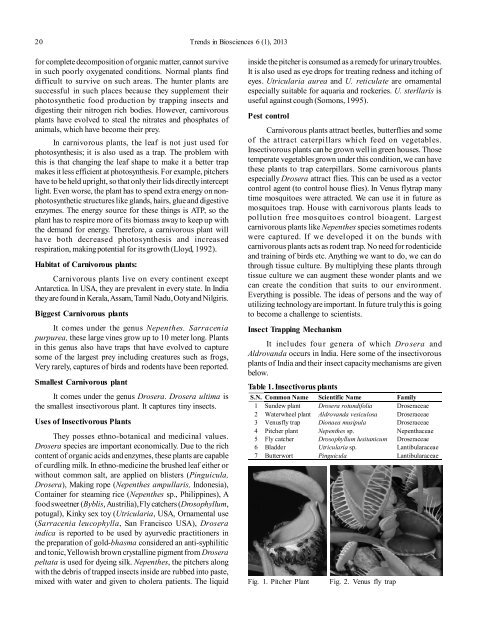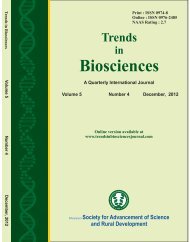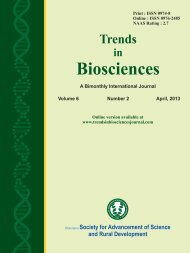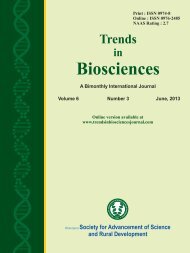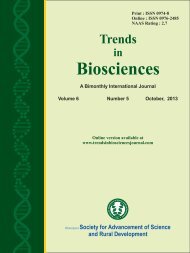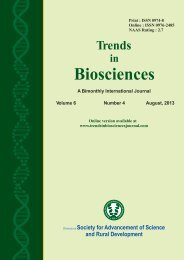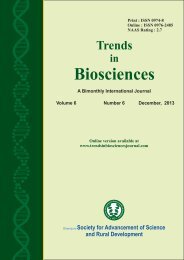TRENDS IN BIOSCIENCES 6-1, 2013 EDITION
CALL FOR RESEARCH PAPERS
CALL FOR RESEARCH PAPERS
Create successful ePaper yourself
Turn your PDF publications into a flip-book with our unique Google optimized e-Paper software.
20 Trends in Biosciences 6 (1), <strong>2013</strong><br />
for complete decomposition of organic matter, cannot survive<br />
in such poorly oxygenated conditions. Normal plants find<br />
difficult to survive on such areas. The hunter plants are<br />
successful in such places because they supplement their<br />
photosynthetic food production by trapping insects and<br />
digesting their nitrogen rich bodies. However, carnivorous<br />
plants have evolved to steal the nitrates and phosphates of<br />
animals, which have become their prey.<br />
In carnivorous plants, the leaf is not just used for<br />
photosynthesis; it is also used as a trap. The problem with<br />
this is that changing the leaf shape to make it a better trap<br />
makes it less efficient at photosynthesis. For example, pitchers<br />
have to be held upright, so that only their lids directly intercept<br />
light. Even worse, the plant has to spend extra energy on nonphotosynthetic<br />
structures like glands, hairs, glue and digestive<br />
enzymes. The energy source for these things is ATP, so the<br />
plant has to respire more of its biomass away to keep up with<br />
the demand for energy. Therefore, a carnivorous plant will<br />
have both decreased photosynthesis and increased<br />
respiration, making potential for its growth (Lloyd, 1992).<br />
Habitat of Carnivorous plants:<br />
Carnivorous plants live on every continent except<br />
Antarctica. In USA, they are prevalent in every state. In India<br />
they are found in Kerala, Assam, Tamil Nadu, Ooty and Nilgiris.<br />
Biggest Carnivorous plants<br />
It comes under the genus Nepenthes. Sarracenia<br />
purpurea, these large vines grow up to 10 meter long. Plants<br />
in this genus also have traps that have evolved to capture<br />
some of the largest prey including creatures such as frogs,<br />
Very rarely, captures of birds and rodents have been reported.<br />
Smallest Carnivorous plant<br />
It comes under the genus Drosera. Drosera ultima is<br />
the smallest insectivorous plant. It captures tiny insects.<br />
Uses of Insectivorous Plants<br />
They posses ethno-botanical and medicinal values.<br />
Drosera species are important economically. Due to the rich<br />
content of organic acids and enzymes, these plants are capable<br />
of curdling milk. In ethno-medicine the brushed leaf either or<br />
without common salt, are applied on blisters (Pinguicula,<br />
Drosera), Making rope (Nepenthes ampullaris, Indonesia),<br />
Container for steaming rice (Nepenthes sp., Philippines), A<br />
food sweetner (Byblis, Austrilia), Fly catchers (Drosophyllum,<br />
potugal), Kinky sex toy (Utricularia, USA, Ornamental use<br />
(Sarracenia leucophylla, San Francisco USA), Drosera<br />
indica is reported to be used by ayurvedic practitioners in<br />
the preparation of gold-bhasma considered an anti-syphilitic<br />
and tonic, Yellowish brown crystalline pigment from Drosera<br />
peltata is used for dyeing silk. Nepenthes, the pitchers along<br />
with the debris of trapped insects inside are rubbed into paste,<br />
mixed with water and given to cholera patients. The liquid<br />
inside the pitcher is consumed as a remedy for urinary troubles.<br />
It is also used as eye drops for treating redness and itching of<br />
eyes. Utricularia aurea and U. reticulate are ornamental<br />
especially suitable for aquaria and rockeries. U. sterllaris is<br />
useful against cough (Somons, 1995).<br />
Pest control<br />
Carnivorous plants attract beetles, butterflies and some<br />
of the attract caterpillars which feed on vegetables.<br />
Insectivorous plants can be grown well in green houses. Those<br />
temperate vegetables grown under this condition, we can have<br />
these plants to trap caterpillars. Some carnivorous plants<br />
especially Drosera attract flies. This can be used as a vector<br />
control agent (to control house flies). In Venus flytrap many<br />
time mosquitoes were attracted. We can use it in future as<br />
mosquitoes trap. House with carnivorous plants leads to<br />
pollution free mosquitoes control bioagent. Largest<br />
carnivorous plants like Nepenthes species sometimes rodents<br />
were captured. If we developed it on the bunds with<br />
carnivorous plants acts as rodent trap. No need for rodenticide<br />
and training of birds etc. Anything we want to do, we can do<br />
through tissue culture. By multiplying these plants through<br />
tissue culture we can augment these wonder plants and we<br />
can create the condition that suits to our environment.<br />
Everything is possible. The ideas of persons and the way of<br />
utilizing technology are important. In future truly this is going<br />
to become a challenge to scientists.<br />
Insect Trapping Mechanism<br />
It includes four genera of which Drosera and<br />
Aldrovanda occurs in India. Here some of the insectivorous<br />
plants of India and their insect capacity mechanisms are given<br />
below.<br />
Table 1. Insectivorus plants<br />
S.N. Common Name Scientific Name Family<br />
1 Sundew plant Drosera rotundifolia Droseraceae<br />
2 Waterwheel plant Aldrovanda vesiculosa Droseraceae<br />
3 Venusfly trap Dionaea musipula Droseraceae<br />
4 Pitcher plant Nepenthes sp. Nepenthaceae<br />
5 Fly catcher Drosophyllum lusitanicum Droseraceae<br />
6 Bladder Utricularia sp. Lantibularaceae<br />
7 Butterwort Pinguicula Lantibularaceae<br />
Fig. 1. Pitcher Plant<br />
Fig. 2. Venus fly trap


